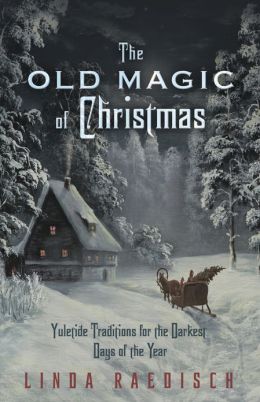If, like me, you have an interest in the darker side of the darkest days of the year, you’ll enjoy this book. Written with humor and charm, it explores many of the less-sparkly aspects of Yuletide lore from northern Europe (Germany, the British Isles, and Scandinavia) with a few brief forays to Italy and Greece. In these pages you’ll meet not just Krampus and the Wild Hunt but the Elves in all their guises, the Pelzmarten and other figures who are just as likely to steal away your gifts (or your children!) as they are to chase you through the dark night or leave you cowering beneath your bed.
I have to admit to being delighted by this book, despite the darkness of the contents. We may put up glittering decorations, hang strings of lights and set out candles to dispel the darkness at Midwinter, but that darkness is still there, looming just outside the pool of light cast by the closest lamp. This book celebrates that darkness and shows us how to resonate with it rather than ignoring it or pretending we have control over it.
The author follows the many tangled threads of European Yuletide tradition back through the centuries, showing the reader where they cross and connect through Pagan and quasi-Christian practice and secular folklore. I thought I was already familiar with most European Winter Solstice traditions, but I learned a lot of new and fascinating lore in these pages.
The layers of customs and traditions are fascinating. Reading this book, you can follow the threads for a particular date: January 6 is Epiphany but is also Three Kings Day and Perchta’s Day. Or you might trace your way through the layers of meaning of the distaff, whose etymology is related to the dísir, the Norse ancestral fate goddesses. You might also follow the connections between geographic regions, as you read about the ways people traveled or migrated and carried their beliefs across Europe.
This fascinating book provides not just information to absorb, but activities that let you bring this collection of folklore and tradition to life. The author has included fun crafts related to each section of the book. These easy-to-make projects can be displayed for the whole expanse of the holiday season, and most are simple enough for children to help with. These crafts masquerade as ‘ordinary’ holiday decorations so the neighbors won’t even know your window adornments call to the Elves and the Old Gods. I’ll be adding several of these items to my holiday decorations this year.
A number of delicious recipes accompany the folklore, allowing you to cook up some traditional holiday fun. Instead of cookies for Santa, this year you might try leaving porridge for the Tomten or milk for the Elves. Like the crafts, the recipes are simple and straightforward, with clearly-written instructions.
I found the ‘Christmas Witch’s Herbal’ section especially interesting. I have a background as an herbalist and I still discovered many new bits of magical and folkloric information about the plants commonly used during the holidays. You won’t find information about teas or other herbals to ingest, however; most of the traditional Yuletide greens are poisonous!
The calendar at the end of the book neatly sorts all the rituals, traditions and festival into chronological order so you can slot them into your own holiday calendar as desired, or look up any date just for fun. I’ll be adding several new observances myself.
This book is going on the shelf alongside my other favorite Winter Solstice resources, and I’m sure I’ll re-read it every year, for all the fascination and depth it will add to the season.
~review by Laura Perry
Author: Linda Raedisch
Llewellyn Publications, 2013
pp. 281, $16.99

